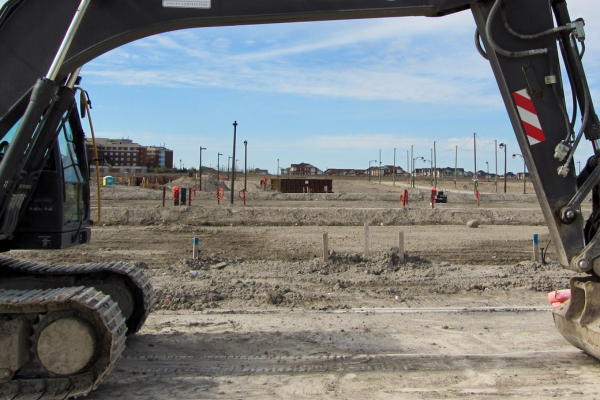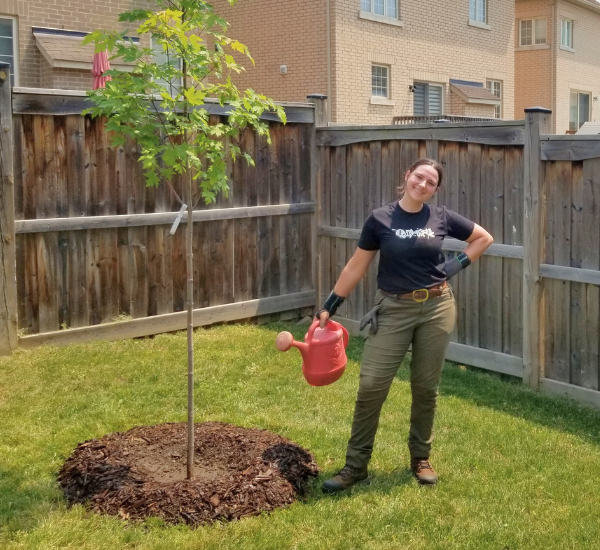There are so many things I love about planting new trees - the freshness of spring air, the earthy scents and the camaraderie I feel with fellow planters. Looking across a new development’s cascading rows of grass-laid backyards, I’ve felt there’s nothing quite as rewarding as witnessing a community's vibrant green transformation with the magic touch of native trees, shrubs or perennials.
However, planting in newly developed neighbourhoods can pose challenges because of poor soil conditions. Constructing new developments often involves removing two to three feet of native topsoil. What’s left behind is dense, clay soil, which is further compacted by heavy construction equipment. After construction, a thin layer of topsoil and sod is added to hide the clay below. When most of the soil consists of hard clay, the ground struggles to retain rainwater. The absence of shade-providing trees can exacerbate the problem, especially during a drought, as the topsoil quickly dries out, and the dense clay below prevents water from penetrating into the ground.
Fortunately, there are special techniques available to ensure successful planting, even in difficult soil conditions. At LEAF, we also offer native species that can tolerate and thrive in these compacted soil conditions.

The Power of Planting in a New Neighborhood
As a tree planter for LEAF, I have seen firsthand the transformative power of planting trees in new developments. I recall a particular planting day when I was working away in the hot sun, digging up the heavy clay and feeling exhausted after planting the seventh tree in that neighbourhood. Down a few blocks, I could see trees in backyards that LEAF had planted in previous seasons. Their leafy shade and vibrant greenery were already starting to shape the neighbourhood's aesthetic character. I distinctly remember imagining how in ten to fifteen years, this row of backyards would become a lush archway of canopy that would transform the sun-scorched yards and create habitat to invite back the wildlife that likely existed before the neighbourhood was built.

Over time, trees can shape the lived experience of community members in new developments in powerful ways through the benefits they provide.
Benefits of Trees in New Developments
Based on my experiences planting in newer developments, here are four reasons why I think you should plant trees on your new development property!
- Privacy: Trees act as natural barriers, creating a visual privacy shield for homeowners seeking a sense of seclusion. The privacy trees can create in a neighbourhood helps increase a sense of security and tranquillity, particularly in densely populated areas.
- Shade: Beyond privacy, trees bring invaluable shade to your neighbourhood. As they mature, these leafy giants offer respite from the scorching sun, creating cool havens for outdoor activities and relaxation. Not only will you enjoy the more pleasant conditions, but your shrubs, flowers and other plants will have a better opportunity to thrive!
- Energy efficiency: The shade provided by trees also plays a crucial role in energy efficiency. Strategically planted deciduous trees that shade your home in the summer help reduce the need for air conditioning, leading to reduced energy consumption and lower utility bills. Meanwhile, the year-round foliage of evergreen trees can block winter winds, keeping your home warm and comfortable throughout the colder months.
- Higher property values: If that’s not enough to convince you, the presence of trees directly impacts property values. Studies consistently show that neighbourhoods adorned with trees and other well-maintained greenery command higher property values. Homebuyers are often willing to pay more for a residence surrounded by a lush and well-treed environment. This increase in property value becomes a shared benefit for the entire community, contributing to the overall desirability of the neighbourhood.

A Love Letter to Your Community
Planting trees is an acknowledgment of collective ecological responsibility and is an act of service to your immediate community. By creating corridors of green connectivity, trees help bridge the gap between urban and rural environments. This connectivity supports biodiversity by creating habitat for pollinators and other wildlife, contributing to a healthier ecosystem.
Green spaces adorned with trees also become communal areas where residents can gather, socialize and enjoy nature. The presence of trees has been linked to reduced stress levels, improved mood and enhanced overall mental health.
So, there you have it: planting trees can bring a wealth of personal and communal benefits to our neighbourhoods. By increasing the tree canopy, we improve the health of our environment and the mental well-being of our neighbours, the property value of our homes and the aesthetics of our surroundings. LEAF’s subsidized planting initiatives help add charm and character to new neighbourhoods, and over the years, these new development landscapes will take on a green life of their own.
Start Planning Today
If your new development feels barren and your backyard could use more greenery, contact us today to get growing! LEAF offers a variety of hardy native trees and shrubs through our subsidized Backyard Tree Planting Program. Check out our Homeowners page to get started on tree planting and our Shrubs, Garden Kits, and Pawpaws page to learn more about how to order native shrubs.
Amba is the Residential Planting Programs Assistant at LEAF.
LEAF offers a subsidized Backyard Tree Planting Program for private property. The program is supported by the City of Toronto, the Regional Municipality of York, the City of Markham, the Town of Newmarket, the Regional Municipality of Durham, the Town of Ajax, the Township of Brock, the Municipality of Clarington, the City of Oshawa, the City of Pickering, the Township of Scugog, the Town of Whitby and Ontario Power Generation.
